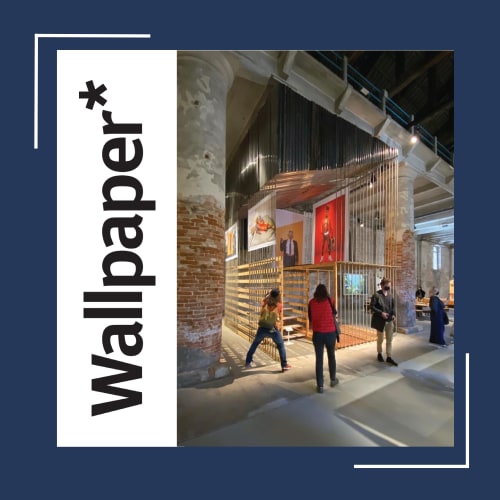Hashim Sarkis’ main show ‘How Will We Live Together?’ at the 2021 Venice Architecture Biennale opens a year later than originally expected, but ponders on questions that are more timely than ever
Venice in the pandemic is a different city, a quiet place with children playing in the narrow streets, families dining outside and an empty St. Mark’s Square. Despite this, as the 17th Venice Architecture Biennale, curated by Hashim Sarkis, prepared to open to the public there was the sense of something undoubtedly special; an international coming together at a time when many of us have to remain within borders.
How Will We Live Together?
Sarkis’ biennale has been postponed twice. Finally opening on 22 May 2021, the Professor and Dean of the School of Architecture and Planning at MIT and founder of Hashim Sarkis Studio posed the question How Will We Live Together?
The theme has only gained resonance as the world has been forced to come together to find solutions or suffer the direst of consequences. The show offered answers to this question, ‘As Diverse Bodies’, ‘As New Households’, ‘As Emerging Communities’ looking at social theory, forgotten craft combined with technological innovation and the speculative, even interplanetary.
How are we to live alongside one another if we do not consider what makes each of us uniquely diverse? In As Diverse Bodies, Sarkis proposes design for new bodies in the shape of a male maternity suit for trans men by artist Ani Liu. This sits alongside the installation Your Restroom is a Battleground, by Matilde Cassani, Ignacio G. Galán and Iván L. Munuera, which tackles issues of the fundamental rights around private, public and shared toilet facilities around the world from trans rights to sanitation. If we don’t accept our diverse needs on this fundamental level when it comes to the spaces we use and inhabit, how are we to co-exist harmoniously?
He then looks at another aspect of the architecture of our bodies, their biology. By presenting the biological systems alongside technological ones Hashim Sarkis looks at them not as opposing forces but as complementary and intertwined. Magic Queen by interdisciplinary architecture and transmedia practice MAEID’s is an ‘autonomous techno-organic environment’, an evolving landscape resembling something between a huge anthill and a fantasy planetary landscape sits next to the satirical work by Tim Parsons and Jessica Charlesworth Catalog for the Post Human which includes imagined objects such as a daily micro dosing kit.
Working from the inside outwards we move from the architecture of our bodies onto our households, kicking off with changing demographics. The exhibition is deliberately diverse not solely out of a desire to be inclusive but because, in Sarkis’ eyes, the greatest innovations in architecture are no longer solely coming out of The West in our post-internet world. He highlights this with KEJA by Osbourne Macharia, inspired by the millennial creatives working out of slums in Nairobi, facilitated by internet access.
New takes on old ideas
Taking into consideration the post-internet and the post-human Sarkis also takes on the post-biological or should we say super-biological. The biennale overall explores the potential for new takes on old ideas; this could be a return to using timber or a new climate conscious material using an old modular housing model. While there is an eye on the past, when Hashim Sarkis looks to the future it is always with an ambition for a cohesive, universal approach.
In As Emerging Communities Rolex alumni Atelier Masomi explores how colonial systems can be adapted for a more equal present and future – Rolex is also once again exclusive partner and official timepiece for the event, and have a separate pavilion at the Giardini park (it hosts an exhibition focusing on Atelier Masomi founder Mariam Kamara’s plans for a cultural centre in Niamey, Niger).
The pandemic: an enforced stop
In another section, he asks us to Inhabit New Tectonics. Refuge for Resurgence by Superflux touches on the impact of the enforced stop of the pandemic and using a dining table as its centerpiece looks at opportunities for coexistence in a post-Anthropocene world. It was essential that Sarkis mix the aspirational with the realised to root the narrative of the exhibition in the context of its theme of togetherness.
One of the most impressive of these projects is Los Angeles’ Sixth Street ‘Ribbon of Light’ viaduct replacement in Appealing to Civicness which, when finished promises to alter the city for the better in myriad ways. The exhibition also features the Lot 19 Residential Block, La Défense-Nanterre in Paris by Farshid Moussavi Architects as part of ‘Living Apart Together’, a film exploring the impact of the building’s architecture on the community that lives there. Built in a sought-after area of Paris, the building is a mix of highly priced and affordable homes and in its success in many ways exemplifies Sarkis’ philosophy.
Our relationships with our mental and physical health are changing and in combining traditional medicine with technological advancement we are gaining a greater understanding of internationally diverse viewpoints. This need for unity is urgently stated in this exhibition which, without a firm grounding in actuality, would have lost itself in theory and speculation. However, what Sarkis presents is a combination of our radically changing approach to life, a mixture of ancient and modern with an aspirational eye on the future.


